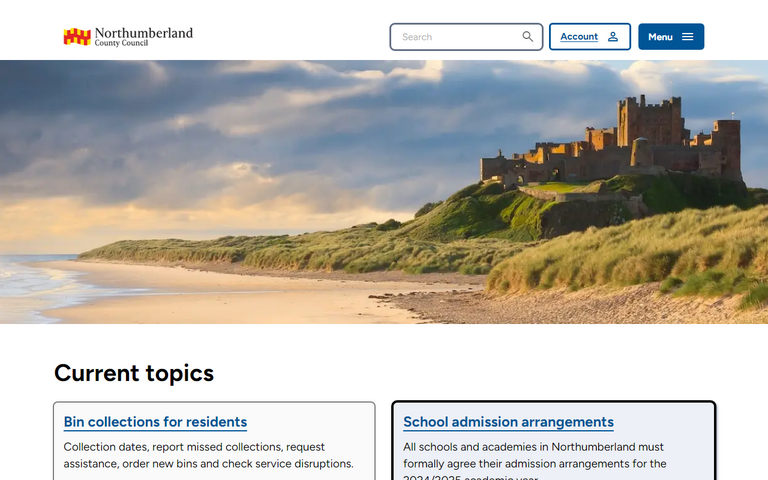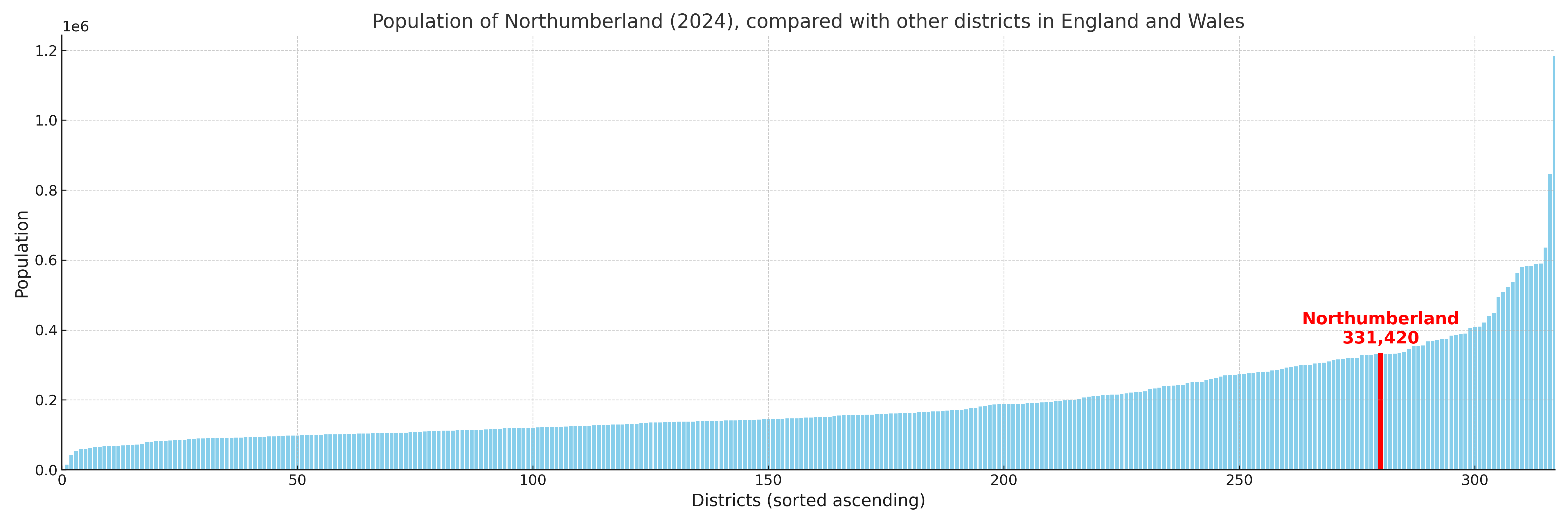Northumberland
§ This page gives an overview of the Northumberland local authority district, bringing together key facts, maps, and data to help you quickly understand the area. One of 361 district profiles on Baseview.
Overview ⁞ Northumberland is England’s northernmost ceremonial county, known for its dramatic landscapes, unspoiled coastline, and rich medieval history. It borders Scotland to the north and stretches from the Cheviot Hills to the North Sea. The area is home to iconic landmarks such as Hadrian’s Wall, Alnwick Castle, and Bamburgh Castle, along with market towns like Hexham and Morpeth. Much of the county remains rural and sparsely populated, offering expansive moorland and national park areas. Northumberland operates under a single unitary authority—Northumberland County Council—and maintains a strong local identity rooted in its border history and natural beauty.
Northumberland Boundary Map
This map shows the official boundary of the Northumberland local authority district, based on the latest geographic data published by the Office for National Statistics (ONS). It provides a clear view of the district’s extent and helps you understand how the area fits within the wider regional and national landscape.
Contains OS data © Crown copyright and database right 2025. Source: Office for National Statistics licensed under the Open Government Licence v3.0.
The administrative boundary of Northumberland can also be viewed on OpenStreetMap: District Boundary of Northumberland.
Key Facts about Northumberland
What region is Northumberland in? Northumberland is in the North East of England, a region within the UK.
What county is Northumberland in? Northumberland is in the county of Northumberland.
Is Northumberland a city? No, Northumberland is not a city. (Note: the UK has 76 officially designated cities.)
Who governs Northumberland? The local government for this district is: Northumberland County Council (Unitary Authority).
▶ Official website of Northumberland County Council 🔗 northumberland.gov.uk

Which police force covers Northumberland? Policing in Northumberland is provided by Northumbria Police 🔗 northumbria.police.uk, which serves 6 local authority districts: Gateshead ⁞ Newcastle upon Tyne ⁞ North Tyneside ⁞ Northumberland ⁞ South Tyneside ⁞ Sunderland.
Northumberland in International Geographies
In the International Territorial Levels (ITLs) hierarchy, Northumberland is within one of ITLs Level 2 area, Northumberland, Durham and Tyne & Wear, that contains the following 4 ITLs Level 3 areas:
(ITL 1) North East
(ITL 2) ⇒ Northumberland, Durham and Tyne & Wear
(ITL 3) ⇒⇒ Durham ⁞ Northumberland ⁞ Tyneside ⁞ Sunderland
The International Territorial Levels are used by OECD member countries for statistical purposes to classify administrative areas. We have this listable page for easy browsing of ITL names and codes: International Territorial Levels.
Constituencies in Northumberland
Northumberland is divided into 4 parliamentary constituencies, listed below in alphabetical order.
A constituency is a specific geographical area that elects one Member of Parliament (MP) to represent them in the House of Commons. The United Kingdom is divided into 650 parliamentary constituencies. We have this list page for easy browsing of all UK parliamentary constituencies: List of Constituencies.
Wards in Northumberland
Northumberland is divided into 66 wards, listed below in alphabetical order.
- Alnwick
- Amble
- Amble West with Warkworth
- Ashington Central
- Bamburgh
- Bedlington Central
- Bedlington East
- Bedlington West
- Bellingham
- Berwick East
- Berwick North
- Berwick West with Ord
- Bothal
- Bywell
- Choppington
- College
- Corbridge
- Cowpen
- Cramlington East
- Cramlington Eastfield
- Cramlington North
- Cramlington South East
- Cramlington Village
- Cramlington West
- Croft
- Druridge Bay
- Haltwhistle
- Hartley
- Haydon
- Haydon and Hadrian
- Hexham Central with Acomb
- Hexham East
- Hexham West
- Hirst
- Holywell
- Humshaugh
- Isabella
- Kitty Brewster
- Longhorsley
- Longhoughton
- Lynemouth
- Morpeth Kirkhill
- Morpeth North
- Morpeth Stobhill
- Newbiggin Central and East
- Newsham
- Norham and Islandshires
- Pegswood
- Plessey
- Ponteland East and Stannington
- Ponteland North
- Ponteland South with Heddon
- Ponteland West
- Prudhoe North
- Prudhoe South
- Rothbury
- Seaton with Newbiggin West
- Seghill with Seaton Delaval
- Shilbottle
- Sleekburn
- South Blyth
- South Tynedale
- Stakeford
- Stocksfield and Broomhaugh
- Wensleydale
- Wooler
In the UK, a ward is a subdivision of a local authority area, used mainly for electoral and statistical purposes. Defined by the ONS, wards represent the primary unit for local elections, each returning one or more councillors to the local council. Wards are also used as a key geography for presenting population and census data.
Parishes in Northumberland
Northumberland is part-parished: 164 civil parishes (listed A-Z below) alongside 1 unparished areas.
- Acklington
- Acomb
- Adderstone with Lucker
- Akeld
- Allendale
- Alnham
- Alnmouth
- Alnwick
- Alwinton
- Amble by the Sea
- Ancroft
- Ashington
- Bamburgh
- Bardon Mill
- Bavington
- Beadnell
- Belford
- Bellingham
- Belsay
- Berwick-upon-Tweed
- Bewick
- Biddlestone
- Birtley
- Blanchland
- Blyth
- Bowsden
- Branxton
- Brinkburn
- Broomhaugh and Riding
- Bywell
- Callaly
- Capheaton
- Carham
- Chatton
- Chillingham
- Chollerton
- Choppington
- Coanwood
- Corbridge
- Cornhill-on-Tweed
- Corsenside
- Cramlington
- Craster
- Cresswell
- Denwick
- Doddington
- Duddo
- Earle
- East Bedlington
- East Chevington
- Edlingham
- Eglingham
- Ellingham
- Ellington and Linton
- Elsdon
- Embleton
- Ewart
- Falstone
- Featherstone
- Felton
- Ford
- Glanton
- Greenhead
- Greystead
- Haltwhistle
- Harbottle
- Hartburn
- Hartleyburn
- Hauxley
- Haydon
- Healey
- Hebron
- Heddon-on-the-Wall
- Hedgeley
- Hedley
- Henshaw
- Hepple
- Hepscott
- Hesleyhurst
- Hexham
- Hexhamshire
- Hollinghill
- Holy Island
- Horncliffe
- Horsley
- Humshaugh
- Ilderton
- Ingram
- Kielder
- Kilham
- Kirknewton
- Kirkwhelpington
- Knaresdale with Kirkhaugh
- Kyloe
- Lesbury
- Lilburn
- Longframlington
- Longhirst
- Longhorsley
- Longhoughton
- Lowick
- Lynemouth
- Matfen
- Meldon
- Melkridge
- Middleton
- Milfield
- Mitford
- Morpeth
- Netherton
- Netherwitton
- Newbiggin by the Sea
- Newbrough
- Newton-by-the-Sea
- Newton-on-the-Moor and Swarland
- Norham
- North Sunderland
- Nunnykirk
- Ord
- Otterburn
- Ovingham
- Ovington
- Pegswood
- Plenmeller with Whitfield
- Ponteland
- Prudhoe
- Rennington
- Rochester
- Roddam
- Rothbury
- Rothley
- Sandhoe
- Seaton Valley
- Shilbottle
- Shoreswood
- Shotley Low Quarter
- Simonburn
- Slaley
- Snitter
- Stamfordham
- Stannington
- Stocksfield
- Tarset
- Thirlwall
- Thirston
- Thropton
- Togston
- Tritlington and West Chevington
- Ulgham
- Wall
- Wallington Demesne
- Warden
- Wark
- Warkworth
- West Allen
- West Bedlington
- Whalton
- Whittingham
- Whittington
- Whitton and Tosson
- Widdrington Station and Stobswood
- Widdrington Village
- Wooler
- Wylam
A civil parish is the lowest tier of local government in England, used for villages, small towns, and suburbs. They have their own local authority, either a parish council or a parish meeting, which provides local services like managing parks, allotments, and streetlights, and represents the community's views to larger councils.
Built-up Areas in Northumberland
Northumberland covers 83 built-up areas, listed below in alphabetical order.
- Acklington
- Acomb
- Allendale Town
- Alnwick
- Amble
- Ashington (Northumberland)
- Backworth *
- Bamburgh
- Beadnell
- Bedlington
- Belford
- Bellingham
- Berwick-upon-Tweed
- Blyth (Northumberland)
- Bomarsund
- Brunton
- Cambois
- Choppington
- Consett *
- Corbridge
- Cornhill on Tweed
- Cramlington
- Dudley (North Tyneside) *
- Ellington (Northumberland)
- Embleton
- Fair Moor
- Felton (Northumberland)
- Gilsland *
- Hadston
- Haggerston
- Haltwhistle
- Haydon Bridge
- Heddon-on-the-Wall
- Hepscott
- Hexham
- Hipsburn
- Horsley (Northumberland)
- Humshaugh
- Lesbury
- Loanend
- Longframlington
- Longhorsley
- Longhoughton
- Lowick
- Lynemouth
- Medburn
- Morpeth
- New Hartley
- Newbiggin-by-the-Sea
- Newton Hall
- Norham
- Ogle
- Otterburn
- Ouston
- Ovingham
- Pegswood
- Ponteland
- Prudhoe
- Redburn
- Riding Mill
- Rothbury
- Seahouses and North Sunderland
- Seaton Delaval
- Seaton Sluice *
- Seghill *
- Shilbottle
- South Broomhill
- Stakeford
- Stamfordham
- Stannington
- Stocksfield
- Swarland
- Throckley *
- Thropton
- Tranwell Woods
- Warkworth
- West Thirston
- Whittingham
- Widdrington Station
- Woodhorn
- Wooler
- Woolsington *
- Wylam
In the UK, a Built-up Area (BUA) is a continuous urban area of at least 20 hectares (0.2 km²), defined by the ONS as land where buildings are generally no more than 200 metres apart, such as towns, cities, or large villages. (Note: A BUA name marked with an asterisk (*) indicates that the area is situated partly in the district of Northumberland.)
Northumberland compared with other districts in the UK
This section shows how Northumberland compares with other local authority districts in the UK, using a variety of measures and rankings.
Northumberland has 66 electoral wards.

Northumberland has a population of 331,420 (2024 mid-year estimate by ONS)

More local statistics and data for Northumberland can be found on the ONS statistics for Northumberland.